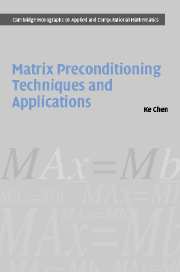Book contents
- Frontmatter
- Contents
- Preface
- Nomenclature
- 1 Introduction
- 2 Direct methods
- 3 Iterative methods
- 4 Matrix splitting preconditioners [T1]: direct approximation of An×n
- 5 Approximate inverse preconditioners [T2]: direct approximation of An×n−1
- 6 Multilevel methods and preconditioners [T3]: coarse grid approximation
- 7 Multilevel recursive Schur complements preconditioners [T4]
- 8 Sparse wavelet preconditioners [T5]: approximation of Ãn×n and Ãn×n−1
- 9 Wavelet Schur preconditioners [T6]
- 10 Implicit wavelet preconditioners [T7]
- 11 Application I: acoustic scattering modelling
- 12 Application II: coupled matrix problems
- 13 Application III: image restoration and inverse problems
- 14 Application IV: voltage stability in electrical power systems
- 15 Parallel computing by examples
- Appendix A a brief guide to linear algebra
- Appendix B the Harwell–Boeing (HB) data format
- Appendix C a brief guide to MATLAB®
- Appendix D list of supplied M-files and programs
- Appendix E list of selected scientific resources on Internet
- References
- Author Index
- Subject Index
- Plate section
6 - Multilevel methods and preconditioners [T3]: coarse grid approximation
Published online by Cambridge University Press: 06 January 2010
- Frontmatter
- Contents
- Preface
- Nomenclature
- 1 Introduction
- 2 Direct methods
- 3 Iterative methods
- 4 Matrix splitting preconditioners [T1]: direct approximation of An×n
- 5 Approximate inverse preconditioners [T2]: direct approximation of An×n−1
- 6 Multilevel methods and preconditioners [T3]: coarse grid approximation
- 7 Multilevel recursive Schur complements preconditioners [T4]
- 8 Sparse wavelet preconditioners [T5]: approximation of Ãn×n and Ãn×n−1
- 9 Wavelet Schur preconditioners [T6]
- 10 Implicit wavelet preconditioners [T7]
- 11 Application I: acoustic scattering modelling
- 12 Application II: coupled matrix problems
- 13 Application III: image restoration and inverse problems
- 14 Application IV: voltage stability in electrical power systems
- 15 Parallel computing by examples
- Appendix A a brief guide to linear algebra
- Appendix B the Harwell–Boeing (HB) data format
- Appendix C a brief guide to MATLAB®
- Appendix D list of supplied M-files and programs
- Appendix E list of selected scientific resources on Internet
- References
- Author Index
- Subject Index
- Plate section
Summary
Whenever both the multigrid method and the domain decomposition method work, the multigrid is faster.
Jinchao Xu, Lecture at University of Leicester EPSRC Numerical Analysis Summer School, UK (1998)This paper provides an approach for developing completely parallel multilevel preconditioners.… The standard multigrid algorithms do not allow for completely parallel computations, since the computations on a given level use results from the previous levels.
James H. Bramble, et al. Parallel multilevel preconditioners. Mathematics of Computation, Vol. 55 (1990)Multilevel methods [including multigrid methods and multilevel preconditioners] represent new directions in the recent research on domain decomposition methods … they have wide applications and are expected to dominate the main stream researches in scientific and engineering computing in 1990s.
Tao Lu, et al. Domain Decomposition Methods. Science Press, Beijing (1992)The linear system (1.1) may represent the result of discretization of a continuous (operator) problem over the finest grid that corresponds to a user required resolution. To solve such a system or to find an efficient preconditioner for it, it can be advantageous to set up a sequence of coarser grids with which much efficiency can be gained.
This sequence of coarser grids can be nested with each grid contained in all finer grids (in the traditional geometry-based multigrid methods), or non-nested with each grid contained only in the finest grid (in the various variants of the domain decomposition methods), or dynamically determined from the linear system alone in a purely algebraic way (the recent algebraic multigrid methods).
- Type
- Chapter
- Information
- Matrix Preconditioning Techniques and Applications , pp. 240 - 288Publisher: Cambridge University PressPrint publication year: 2005

